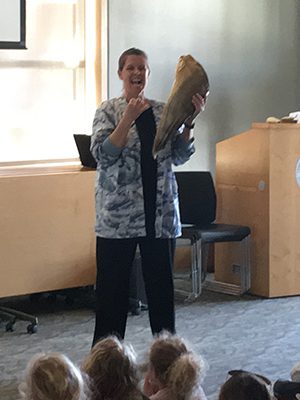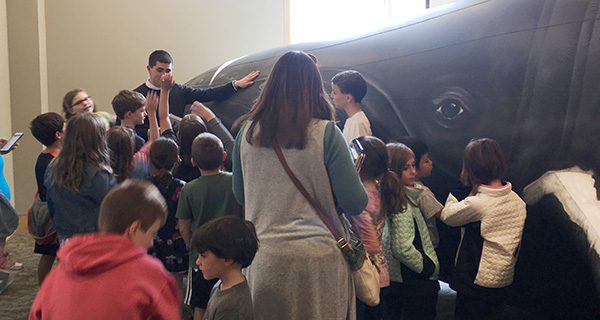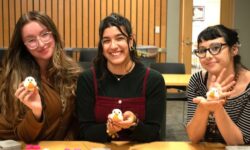[ccfic caption-text format="plaintext"]
By Katrina Margolis
Hometown Weekly Reporter
Cynde McInnis’ favorite whale is named Nile. The first whale trip McInnis took by herself was in 1995, and Nile surfaced headfirst, right next to her boat. McInnis remembers when Nile came back with her first calf in 1998, and she has seen Nile almost every year since.

Cynde McInnis, creator of the Whalemobile, demonstrates what baleen is by holding a group of plates. Photos by Katrina Margolis
This whale model, also known as the Whalemobile, travels all around New England to teach kids about whales. Recently, McInnis made a trip to the Westwood Public Library to share some information about whales, and to help kids fall in love with the amazing creatures around which she has based her career.
“A couple years ago, I had this whale made so I could bring whales to people instead of having people always come out on the boat,” McInnis explained. McInnis works with Cape Ann Whale Watch, however, whale watches can be expensive, and there are only so many people who can fit on one boat.
Instead, McInnis brings the whales to the students.
She began with a mini-lecture, explaining about different species and general whale information. “Whales are mammals. They have hair - believe or not, whales have little whiskers up on their chins - they give birth to live young, the babies nurse, they’re warm blooded, and they breathe air. I’m going to tell you guys that they breathe air probably five times today, because a lot of people think that it’s water that comes shooting up out of the blow hole,” McInnis said. “Did you guys see ‘Finding Nemo’? You know that scene when Marlin and Dory are in the whale’s mouth? And they and a bunch of water goes shooting out of the blow hole? That’s not possible - that’s totally wrong. It’s just air!”
She went on to explain that there are over 85 types of whales, dolphins and porpoises, and they are divided into two groups: baleen whales and toothed whales. “In a whale, there would be two to three hundred plates of baleen. They use this to filter little fish out of the water,” she explained. After giving a general introduction to whales, McInnis blew up Nile’s model, a full-sized humpback. The model took up almost the entirety of the room, bringing about sounds of awe from the children. The kids were welcomed to step inside the stomach of the whale, to learn more about how the animals eat and digest, as well as to remind them that whales breathe air – not water.
McInnis’ Whalemobile travels all over, and an upcoming schedule of events can be found on her website.
























